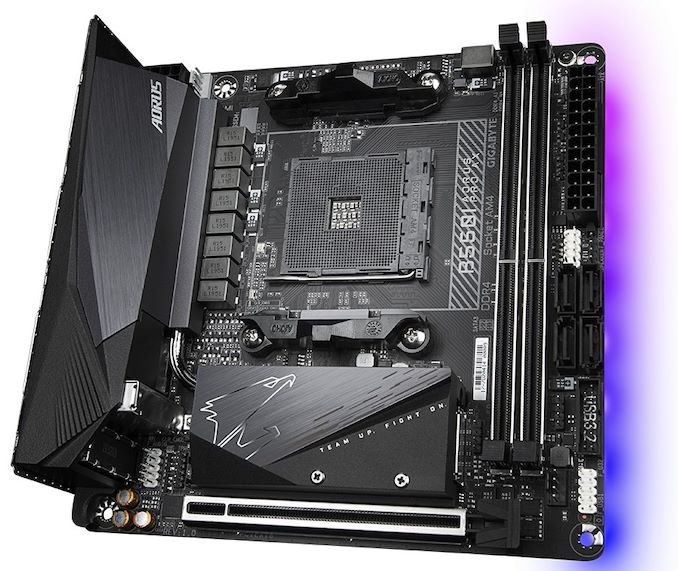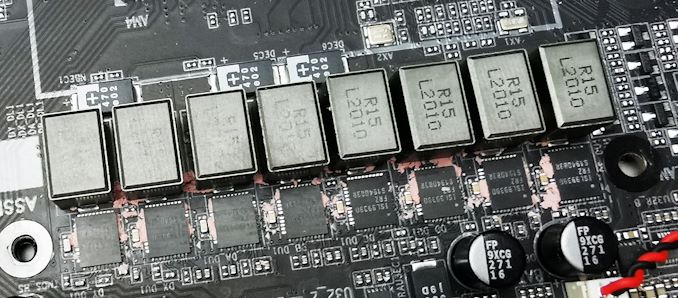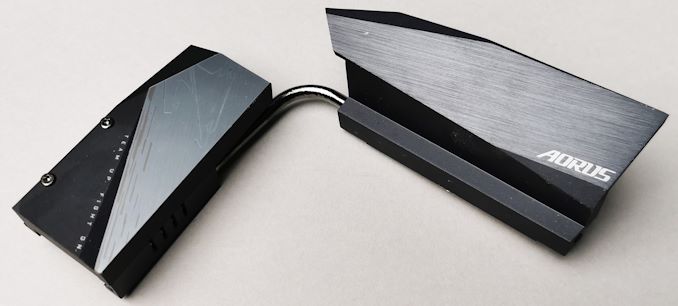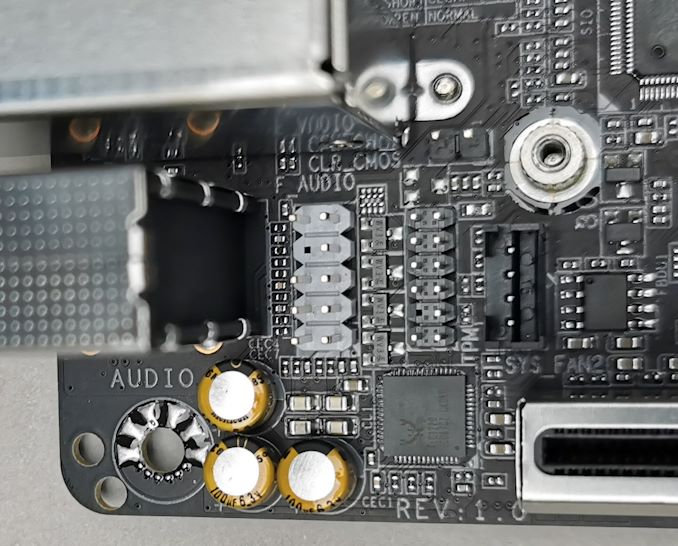The GIGABYTE B550I Aorus Pro AX Motherboard Review: All The Small Things
by Gavin Bonshor on December 7, 2020 10:00 AM ESTVisual Inspection
Looking very closely at the GIGABYTE B550I Aorus Pro AX motherboard, it has a small but capable frame with a very neutral aesthetic. It employs a primarily black and grey design, with a silver combined chipset and front-mounted M.2 heatsink, with one section of RGB LED lighting, which lights up the board's underside along the right. For users looking to add a little more pizazz, GIGABYTE includes an addressable and regular RGB LED strip pairing compatible with a lot of different RGB ecosystems, including Corsair's iCUE and NZXT CAM. However, GIGABYTE has its own called RGB Fusion 2.0.
Despite being mini-ITX, the GIGABYTE B550I Aorus Pro AX has plenty to focus on. Looking at expansion support, there is a single full-length PCIe 4.0 x16 slot, with the capability to install up to one PCIe 4.0 x4 M.2 slot on the front of the board, with a second slot on the rear of the PCB with support for both PCIe 3.0 x4 and SATA drives. There are four SATA ports for SATA devices, which are all straight angled and sit directly below the 24-pin ATX 12 V power input. These SATA ports do include support for RAID 0, 1, and 10 arrays, and they don't share bandwidth with any of the M.2 slots, even when SATA based M.2 drives are installed.
Users familiar with the mini-ITX form factor can appreciate that there will be limitations in connectivity, both internal and external. One of these is prevalent in its support for cooling, with just three 4-pin fan headers available on the B550I Aorus Pro AX model. One of these is dedicated to a CPU fan, while the other two are for chassis fans, although AIO pumps are supported through all three headers.
Memory compatibility looks strong with GIGABYTE's official support for up to DDR4-5100 memory, with a total capacity of up to 64 GB. Both of the memory slots and the full-length PCIe 4.0 x16 slot come with PCIe armor, designed to reinforce the slot to avoid physical damage to the slots when installing hardware. This also gives the slots better structure for heavier components such as NVIDIA's latest RTX 3090 graphics card, which is notoriously large and bulky.
For the power delivery, GIGABYTE is using an 8-phase design, which is being controlled by a Renesas RAA229004 PWM controller. The configuration is split into a 6+2 configuration, with six premium Intersil ISL99390 90 A power stages for the CPU and two ISL99390 90 A power stages for the SoC. On paper, this is one of the most capable mini-ITX models from the B550 models in regards to maximum power output to the CPU, with a maximum output of up to 540 A for the CPU. Delivering power to the CPU is a single 8-pin 12V ATX power connector.
The power delivery heatsink is interconnected to the M.2 and chipset heatsink, a common theme on mini-ITX models. It doesn't include finned heatsinks, so it relies primarily on mass, although the heatsink's top will catch airflow within a chassis. Unlike the X570 variant, there is no cooling fan above the chipset heatsink, which is a plus as it should be more than adequate without one.
The GIGABYTE B550I Aorus Pro AX is using a simplistic yet premium audio setup. It includes three Japanese Nichicon gold audio capacitors, with the driving being done by a Realtek ALC1220-VB HD audio codec. This is cramped in directly next to the end of the full-length PCIe slot, with no EMI shielding and no visible audio PCB segregation. There is also a front panel audio header, which is also powered by the ALC1220HD codec, although it is in this funny little position. This might interfere with the backplates on some of the larger graphics cards.
For a small board such as this one, it has an acceptable amount of connectivity on the rear panel, which is largely down to space restrictions. Starting with USB, the B550I Aorus Pro AX makes use of two USB 3.2 G2 ports, one Type-A, and one Type-C, with four additional USB 3.2 G1 Type-A ports. While this in itself isn't a lot, GIGABYTE does include a USB 3.2 G1 and USB 2.0 front panel heading pairing, which each allows a further four ports (two each) to be added to the system. The networking configuration is premium, with a Realtek RTL8125 2.5 GbE port, with two antenna ports for the Intel AX200 interface with Wi-Fi 6 and BT 5.0 support. Three 3.5 mm audio jacks are driven by a Realtek ALC1220-VB HD audio codec, while a trifecta of video outputs consisting of two HDMI 2.1 and a DisplayPort allows users to utilize the Ryzen 4000 APU's. Finishing off the rear panel is a Q-Flash Plus button.
















76 Comments
View All Comments
romrunning - Monday, December 7, 2020 - link
Almost all, if not all, of the better B550 ITX boards ($180+) released in June/July of this year have 2.5Gb ports. For onboard 10Gb, you would have to go with some specialized solutions, like the ASRockRack mini-ITX server boards. They have EPYC-based mini-ITX boards and even a X570 board (X570D4I-2T) with 10Gb.Olaf van der Spek - Tuesday, December 8, 2020 - link
Just buy a PCI-E NIC. Oh wait...;)
Dug - Tuesday, December 8, 2020 - link
or wait.. Bifurcationmkarwin - Tuesday, December 15, 2020 - link
Oh wait.. similar approach could almost be used here... If only they added even more higher speeds USB outs (eg. with TB support) one could use them and plug in some USB NIC dongle as a stop gap interim solution... but the amount of 10/5gbps connectors is at a premium here as well ;)mkarwin - Tuesday, December 15, 2020 - link
Especially since 2.5GbE does not force replacement of cabling... and AFAIK costs on the NICs are somewhat similar if not equal. Heck, I wonder why premium ATX boards come with 2 multigig NICs and premium mITX or mATX do not (besides those AsrockRack server'y solutions that skimp on all the other QoL integrations we've come to expect from home/desktop PC parts).lorribot - Monday, December 7, 2020 - link
I would like to see more variation in the features not offered on ITX boards so they could be cheaper. mATX boards are the cheapest you can buy, but also come with a wide range of options, ITX seem to only come fully loaded.First I would delete any Video out capability as most AMD processors have none built in for the majority of users this is pointless. 2.5Gb networking is not required for most people, 2.5GB switches are few and fa between and definitely of no use in the UK for any internet capability and no router in the UK comes with that so you would have pay out for expensive switches, if you really need to move a lot of data. How about no wireless or only wireless? Or dual gigabit.
Task based designs rather than one size fits all.
mkarwin - Tuesday, December 15, 2020 - link
I almost agree... though not entirely.I'd leave one display output, just to appease corporate overlords and PR departments so they could check the box near the "applicable for Ryzen with integrated Radeon solutions"... As to which one to use, that's another question. Perhaps leave only HDMI would appease most users as this is one standard that's proliferated among displays' connectors the widest... Plus, I'd allow sending digital audio from the integrated audio card through the same HDMI connection. But I'd add such a setting on the BIOS level, so as to remove dependency on OS drivers. That'd tick another box on the feature lists... Alternatively, I'd consider using USB-c connected to the CPU - for the port to be used as a DP over USB3-c as it is done on laptops, or as a iGPU output akin to the USB-c port on the new Radeons... Then again if not used in such a manner allow it to be switched to a very fast general purpose USB with connectivity nearly straight to CPU right within the BIOS to again remove any obstacles from driver/OS reworks/compatibilities...
As to networking - I disagree whole-heartedly. I'd say go with dual multigig ports, preferably X550-class based 10GbE. And if 10GbE is too far, go with 2.5 and 5GbE solutions instead. The internet speeds are not the important, most devices are connected to LANs. And here, higher speeds matter much, especially in mITX forms. Why? Cause one could use external storage of NAS variety - it's easier to add tons of disks and copious amounts of space to NASes than to your PC's small mITX cases ;) Plus, you may want to work more using various network appliances, or in enthusiast markets home servers. And for that purpose, high quality high bandwidth NICs are a must. I'd even go one step further, and consider using 2.5/5GbE on all consumer boards and switching to (Q)SFP+ slots to reduce the costs a bit (though I understand that this instead requires more space which is at a premium in smaller builds/MBs). After all the market adoption is driven by the masses, and currently we're having a chicken and egg situation here - most home networks are still at 1GbE speeds cause there aren't many devices most people are using that come with higher speed wired NICs so there's no push towards higher network gear, and since there's no push this not a lucrative enough market for the netowrk appliance manufacturers to start offering faster devices that could support those higher speeds at the prices an average Joe could find enticing. BTW. the enthusiast market as well as pro market have already gone forward and people are already thinking of jumping ship to 10GbE, either in CAT6A/CAT7 or FC forms. Just check the popularity of Mikrotik's 10GbE SFP+ switches... Plus you need to remember that due to smaller consumer base with mostly enthusiasts and pros, companies can easily price those products accordingly and still sell out batches of products - once the speeds become more widespread the rules of competition and market push would enforce price drops for mass-produced offerings. Plus, you'd really need to use 2.5GbE+ wired speeds to keep up with the WiFi6 speeds ;)
And onto the WiFi debacle - I'd still leave the antenna ports, but instead of WiFi/BT module on board, I'd suggest adding M.2 port for those WiFi/BT devices on the back side or on top of M.2/chipsets - that way they'd get the chance to sell another additional product option, one that is tested and used widely in laptops already with success, one used in their NUC-alikes as well, one that's easily replacable or upgradable, and one that could reduce the pricepoint for those not wanting to shell out on sucha feature... That's a fair bit more interesting boxes to tick for the PR people and the "start small go big" mantra...
And speaking of M.2 connectors, I'd really appreciate if more devices actually came with support for 22110 sized ones - even though 2280 has become the defacto standard for M.2 NVMe drives, the 22110 is the one used by the more pro-oriented/server-grade markets due to those usually packing PLP circuitry on board.. That's a tiny QoL feature that could easily differentiate the devices on offer and again allow the PR reps to show how one product stacks better than the competition...
And speaking of server-grade stuff that most MB manufacturers are already doing very well in their server departments, why not dig deeper into those roots as well and start adding BMC in those prosumer solutions? Those in the know would appreciate it, others might find it an extra feature... Sure, Intel has vPro and AMD has joined the game with their Pro series but neither can replace a full BMC solution for remote working/helping...
Now going wireless only solution could sound great on paper but would require a lot work - they'd have to allow WiFi connection management including security/WPS on BIOS level to allow eg. PXE. Furthermore, they'd have to polish the BT issues/stack on BIOS level - so eg. they could allow BT keyboard/mice for system management, so OS agnostic. Furthermore, they might have to instead get in touch with various key/mice manufacturers and license built-in RF transmitters to speak with those devices - its doable and possibly easier than getting BT stack working fully on BIOS/firmware level... Than maybe they'd have to discuss opening to NFC communication. And going back to BT, they'd have to get AptX and similar certs to speak better with wireless audio devices - and that's additional costs many CEOs wouldn't agree to unless presented with a clear ROI numbers... and possibly market adoption of competition's products with similar feature sets. Similarly going the wireless route would necessitate digging into the HDMI over WiFi/WirelessHDMI standards which are not yet adopted widely. I dare say that it's easier to sell the idea of going full 10GbE wired product stacks than finding the wireless HDMI solution markets. Of course having a built-in LTE/5G modem could well play the "going wireless" game in any product stacks but there is another issue going wireless requires - MBs would have to get option to create WiFi networks and act as APs/WiFi routers thus the BIOS would have to get at least a simple WiFi sharing functionality....
Dual gigabit? Nah, that's too restrictive - either think of 4x1GbE or 2x2.5/5GbE or 10GbE. Don't let yourself be rooted in the years old standard that should have already been replaced in all cabled devices.
Now the task based designs could fare great if their implementation was made correctly...
But I'd just consider some copanies thinking of the fact that nowadays smaller boards are not chosen mostly by average users, rather these are power users, enthusiasts, pros... And they need something more for a product to be seen as a premium offering. For example, Gigabyte could have easily gone the Xtreme Waterforce route and create and sell a mITX board with integrated full-board monoblock+pump+res (or monoblock only) that covers CPU+VRM+SoC+M.2 - I bet such a product could easily find new homes among the target consumer group ;) Especially if they priced it right. Heck, Asus could just reach out to EkWB/Bitspower for a cooperation and release boards with blocks out-of-the-factory... I'd say nowadays those smaller monoblocked boards would sell like cupcakes (provided they are priced reasonably) and they could push more people towards custom loops, thus also proliferating monoblocked GPU sells. Or maybe go even one step further and get in touch with both block maker and AIO manufacturers - I think every company would like to consider such cooperation offer to sell truly integrated solutions... for the AIO companies that would have necesiteated only slight adjustments to pump/block/reservoir-combo units to adjust for the full coverage solutions, but you could get far better temps throughout the lifecycle and these would still sell well for the mITX market or even mATX - 240mm/280mm/360mm rads would suffice to cool such full coverage heat sources...
DiHydro - Monday, December 7, 2020 - link
Have you tried to use Smart Fan 5? I found it to be horrible! I have a Noctua CPU cooler and it had the fans spinning at near max, even when the CPU temp was down in the 50°C range.Gigaplex - Tuesday, December 8, 2020 - link
I suspect you're doing it wrong, then. SF5 is working great for me. The fan curve follows the temperatures I set just fine. Each fan port gets its own fan curve, so maybe you're setting the curve on the wrong port?DiHydro - Sunday, December 13, 2020 - link
I did see that it has per fan curves, but the out-of-the-box curves are terribly aggressive. Even in the so called silent mode.